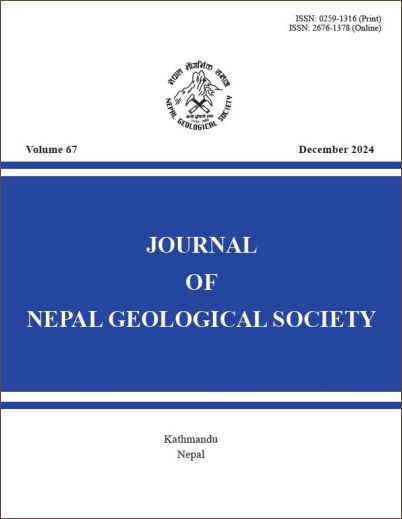Thrust boundary delineation and metamorphic zonation mapping through petrography in the Tamghas-Arkhabang section, western Nepal
DOI:
https://doi.org/10.3126/jngs.v67i1.74582Keywords:
Petrography, Metamorphism, Jajarkot Thrust Sheet, Lesser Himalaya, central NepalAbstract
This study analyzes the mineral paragenesis and microstructural characteristics of rocks from the Tamghas-Arkhabang section to delineate a thrust boundary and create a detailed metamorphic zonation map. A 1:25,000 scale geological map was prepared, and representative rock samples from each stratigraphic unit were systematically collected for petrographic analysis. Fourteen thin sections were examined to understand the deformation and metamorphism in the region. Field observations such as fault breccias, fault gouge, lineation, and slickensides, along with petrographic evidence of inverted and dynamic metamorphism, cataclastic deformation, and ribbon quartz, suggest the presence of a thrust equivalent to the Mahabharat Thrust (MT), a significant tectonic feature in the study area. Microstructural indicators like undulose extinction, grain boundary migration, recrystallisation, and deformation lamellae in quartz further confirm this thrust's existence. Two distinct carbonate successions were identified: the southern unit correlates with the Lesser Himalayan sequence, while the northern, more metamorphosed carbonate unit is associated with the Bhimphedi Group, part of the Jajarkot Thrust Sheet. Stratigraphic continuity is disrupted in some sections, where quartzite and schist replace the basal carbonate strata, likely due to thrusting. The thrust's propagation has impacted both footwall and hanging wall rocks, evidenced by features such as rotated garnets with spiral inclusions. Three metamorphic zones—chlorite, biotite, and garnet isograd—indicate progressive metamorphism linked to thrust tectonics, revealing an inverted metamorphic sequence in the region.
Downloads
Downloads
Published
How to Cite
Issue
Section
License
© Nepal Geological Society




